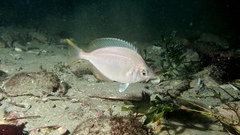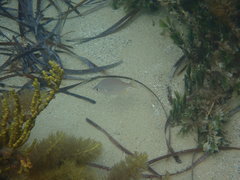The Silverbelly is a schooling species found in near rocky reefs and seagrass beds in bays, and coastal areas. The Silverbelly uses its protrusible mouth to poke around for invertebrates on sandy and muddy bottoms. Body deep, compressed, forehead convex, snout pointed with protrusible jaws; dorsal and anal fins long based, low at front, progressively becoming taller; tail base slender, caudal fin slightly forked. Silvery, darker above, scales with blue and yellow on lower scales, dorsal fin with a yellow margin.
What habitats does Parequula melbournensis live in?
Sandy and muddy areas in coastal waters and bays, often near seagrass.
What is the distribution of Parequula melbournensis?
Coastal waters of southern Australia
How big does Parequula melbournensis grow?
Usually 10 cm long head to tail tip cangrow up to around 21cm
Disclaimer: A lot of work goes into trying to identify and ensure accurate identifications are made and that the listed Descriptions, Sizes, Habitats and Distribution information is as accurate and valid as possible. Unfortunately, information in this arena is ever changing and as such no guarantee can be offered that it is correct or currently valid as a result the information is provided as a guide, and it is always suggested that you do a little research to ensure you have the latest and most accurate information. View the reference's or bibliography I welcome any feedback and comments on the information provided.






